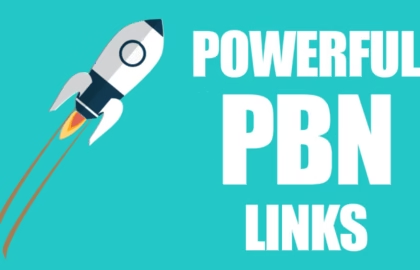Buy PBN Links In the fast-paced world of search engine optimization (SEO), backlinks are the lifeblood of ranking power. And when it comes to acquiring strong backlinks that can actually move the needle, PBN links (Private Blog Network links) remain one of the most controversial, misunderstood, yet highly effective strategies in the SEO arsenal.
In this comprehensive guide, we’ll cover everything you need to know about buying PBN links in 2025. From what they are, how they work, the risks involved, and how to safely buy them — this guide leaves no stone unturned.
Table of Contents
- What Are PBN Links?
- How Do PBN Links Work?
- Why People Buy PBN Links
- Are PBN Links Safe?
- White Hat vs Black Hat SEO: Where Do PBNs Stand?
- How to Identify a High-Quality PBN Link
- Where to Buy PBN Links
- How Much Do PBN Links Cost?
- Common Mistakes When Buying PBN Links
- Best Practices for Buying PBN Links Safely
- Do PBN Links Still Work in 2025?
- Final Thoughts
1. What Are PBN Links?
A Private Blog Network (PBN) is a network of authoritative websites used to build backlinks to a main website, with the goal of improving its search engine rankings.
- These are usually expired domains that once had real content and backlinks.
- SEOs revive them with new hosting and content.
- Links placed on these PBN sites pass on link juice to the target site.
So, a PBN link is simply a backlink from a website in a private blog network.
2. How Do PBN Links Work?
PBN links work by leveraging the authority and backlink profile of old, expired domains.
Here’s how:
- A domain with real backlinks from trusted sources (like Forbes or Huffington Post) is bought after expiration.
- It’s recreated to appear as a real, legitimate blog.
- SEO-savvy content is published on it.
- A contextual link is inserted pointing to your target website.
- This link passes on trust and authority, helping your rankings improve.
Google’s algorithm still relies heavily on backlinks. So when the link comes from a high-authority site (even if it’s a PBN), it can still positively affect your site’s ranking.
3. Why People Buy PBN Links
Let’s be honest: organic backlink building is hard.
Here’s why many turn to PBNs:
- Faster results: PBN links can improve rankings in weeks.
- Control: You decide anchor text, URL, and link placement.
- Avoid outreach: No need to email hundreds of websites.
- Niche targeting: Choose PBNs in your exact niche.
- Cost-effective: Cheaper in the long run than PR campaigns.
For affiliate marketers, local SEOs, and small business owners, buying PBN links can offer an immediate boost to visibility and revenue.
4. Are PBN Links Safe?
This is the million-dollar question. The honest answer?
They can be — if done right.
Risks include:
- Google penalties if detected.
- Deindexation of PBN sites.
- Loss of rankings if the PBN is low-quality.
However, high-quality PBNs that are well-maintained, diverse, and not obviously connected are often undetectable.
The key is anonymity, quality, and natural-looking footprints.
5. White Hat vs Black Hat SEO: Where Do PBNs Stand?
PBNs are firmly in the gray hat to black hat territory.
White Hat
- Guest posting
- Outreach
- Digital PR
Black Hat
- PBNs
- Link farms
- Automated link building
But here’s the nuance: many top-ranking sites use PBN links quietly and carefully.
In short: If you’re in a competitive niche, your competitors are probably using PBNs — even if they won’t admit it.
6. How to Identify a High-Quality PBN Link
Not all PBN links are created equal. Buying links from poorly managed networks can do more harm than good.
Look for:
- Clean backlink profile (no spammy links)
- Indexed in Google
- Unique IP and hosting
- Real content and regular updates
- Niche relevance
- No obvious footprint (e.g., same theme or same author bio on every site)
Use tools like Ahrefs, Majestic, or SEMRush to analyze the domain’s authority and backlink profile before buying.
7. Where to Buy PBN Links
Here are common sources:
1. SEO Agencies
Some agencies offer “safe PBN links” as part of their SEO packages.
2. PBN Marketplaces
Examples: Legiit, SEOClerk, BlackHatWorld, Fiverr (be careful here — quality varies!)
3. Private Sellers
Some SEOs operate exclusive networks and sell access discreetly via Skype, Discord, or email.
4. Build Your Own PBN
If you’re advanced and want full control, creating your own PBN is the most secure option — but also time-consuming and costly.
8. How Much Do PBN Links Cost?
Prices vary based on domain authority, niche relevance, and seller reputation.
Average Price Ranges:
- Low-quality PBNs: $10–$30 per link
- Mid-tier PBNs: $50–$100 per link
- High-authority niche PBNs: $150–$500+ per link
Tip: Don’t buy cheap links in bulk — quality trumps quantity.
9. Common Mistakes When Buying PBN Links
Avoid these costly errors:
- Using exact-match anchors too often
- Buying from the same seller repeatedly
- Not vetting the PBN site properly
- Linking from deindexed or penalized domains
- Linking to your money site too aggressively
- Buying hundreds of links at once
Always prioritize diversity, quality, and moderation.
10. Best Practices for Buying PBN Links Safely
If you’re going to buy PBN links, follow these safety guidelines:
✅ Use Diversified Anchor Text
Mix branded, generic, and long-tail anchors.
✅ Spread Links Across Multiple Sites
Don’t link from 10 articles on the same PBN site to your homepage.
✅ Keep It Natural
Add outbound links to authority sites like Wikipedia or Forbes to mask intent.
✅ Maintain a Balanced Link Profile
Combine PBNs with guest posts, citations, HARO links, and Web 2.0s.
✅ Rotate Your Link Sources
Don’t rely solely on PBNs. Use them as part of a diverse SEO strategy.
11. Do PBN Links Still Work in 2025?
Yes — PBN links still work in 2025.
Google’s algorithm has evolved, but it still relies heavily on backlinks. Well-built PBNs with aged domains and clean metrics continue to pass ranking power.
However, Google is also better than ever at detecting manipulative link schemes. This means sloppy, spammy PBNs get penalized fast.
The secret to success today?
- Smaller networks
- Higher quality
- Real content
- Careful footprint management
In short, quality over quantity is more critical than ever.
12. Final Thoughts
Buying PBN links isn’t for everyone.
- If you’re working on a brand that can’t risk a penalty, you may want to stick with white-hat methods.
- But if you’re running affiliate sites, niche blogs, or local SEO campaigns in competitive industries — PBNs can give you a powerful edge.
The key is buying from trusted sources, vetting every site carefully, and always putting quality first.
TL;DR Summary
| Feature | Details |
|---|---|
| ✅ Effectiveness | Still powerful in 2025 |
| ⚠️ Risk Level | Medium to High |
| 💰 Cost | $50–$500 per link |
| 🧠 Strategy | Use sparingly, mix with other links |
| 📈 Ideal For | Affiliate sites, local SEO, niche sites |
Disclaimer: Use PBNs at your own risk. While many SEOs use them successfully, they are against Google’s guidelines and can lead to penalties if misused.
Want help finding high-quality PBN links? Let me know — I can help you vet sellers or build a strategy.
Would you like a downloadable version of this article (PDF or DOCX)? Or want it optimized for WordPress with internal links and structure?
4o






